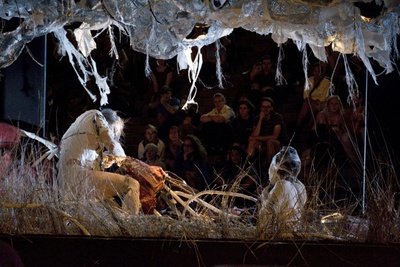The Profundity Of The Caravan Project
By Bansie Vasvani

Eikokoma, Caravan, courtesy MoMA, New York
For a first-time viewer, Eiko and Koma’s slow moving yet highly sculpted performance piece entitled the Caravan Project, at the Agnes Gund Garden Lobby at MoMA, New York, was a treat. Staged beneath Tony Smith’s canvas, Untitled (1962), and in front of Rodin’s Monument to Balzac (1898), this free flowing “museum by delivery” installation carved out and held a distinct place amidst its distinguished company.
The Caravan Project is performed in and around a specifically modified trailer fitted for the setting. At MoMA, the internally lighted trailer resembled the warm interior of a bird’s nest. Leaves, potato stems, and other organic detritus hung from the walls and lined the inner surface of the caravan that was open on all four sides for easy viewing. Then two somnambulant figures painted in white and barely clothed in tattered white garb made their presence felt.
Imbued by the Japanese Butoh dance tradition of performing in white body makeup with no set style but often involving playful and grotesque imagery, Eiko and Koma’s art is best described as occurring in glacially slow movements that at times are almost imperceptible. Yet what emanates from the womb of this free-floating caravan bedecked and overflowing with natural elements is a sense of something eerily primal that appeals to very basic emotions. Combined with the gradual unraveling of miniscule gestures and body shifting, a mood at once tragic and uplifting is created. Reminiscent of Hiroshima survivors abandoned and appearing to decay in plain sight, Eiko and Koma’s dreamlike state somehow draws us in. Their seeming unawareness of their surroundings communicates a desire to be seen almost outside the human experience, in order to reconnect with a more universal sense of being.
As viewers walked around the caravan peering in from all four sides, the excruciatingly measured performance with no specific beginning, ending, or narrative, continued to hold its own. Despite the lack of a soundtrack to shape the performance and focus our attention, the dance exuded a deep connection with nature, tugging at elemental emotions of hunger, death, and dependence. A potpourri of varied generations, genders, and ethnic representations surrounded the dancers as they unspooled a spontaneous, unchoreographed performance appearing to be neither robotic nor artificial. The audience was kept spellbound by the performers’ ability intrinsically to subvert and transcend any common notions of time and space.
While the two dancers conveyed the fragility of the human condition through their delicate bodies, movements and appearances, what played out was a deep understanding and connection between them. Camaraderie, gender roles, expectations, and dependence unfurled with quiet deliberateness. This was experimental dance, as much as a view into the complicated relationship between a man and woman. Here unexpected power structures were displayed with understated certitude. In one instance, when Koma, the male figure, attempted to subjugate and dominate Eiko, his female counterpart, by literally attempting to chain her to the side of the caravan, Eiko expressed her independence by gently but firmly pushing him away.
Perhaps what was so profound about the performance was its ability to remain refreshing even as one walked off and returned after a brief hiatus, or simply became distracted by its laborious pace. So what made for its refreshing quality? The piece evoked a remarkable gamut of emotions from depression to elation through its changing representation of forms, structures, and discipline of movement. It seemed as if the audience gathered and watched less out of bemusement than with a fascination in the show’s ability to connect with our atavistic desires and emotions.
The Caravan Project has been recently revived and staged at various locations since its composition in 1999. Through this itinerant project, the artists hope to reach out to as wide an audience as possible. The performance has been set up at outdoor venues and neighborhoods in various cities in the United States that have evoked different responses from assorted spectators and viewers. At MoMA’s Agnes Gund Garden Lobby in New York, it initiated close and extended looking for the sophisticated museum visitors, and offered a brief period of unlikely, unanticipated meditation in a very busy metropolitan museum setting.
Bansie Vasvani is an independent art critic and writer. She lives in New York City.
